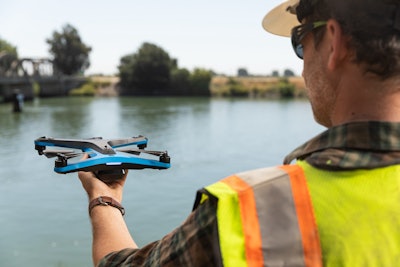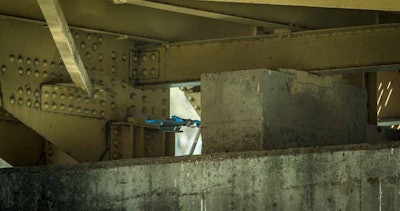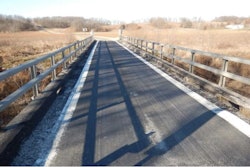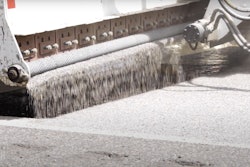 Skydio 2 drone used by NCDOT for bridge inspections. Photo credit: Skydio
Skydio 2 drone used by NCDOT for bridge inspections. Photo credit: SkydioThe North Carolina Department of Transportation has been using drones since 2016 for bridge inspections, but now the agency can use the devices beyond the visual line of sight of the pilot and without visual observers.
It is the first state department of transportation to receive a Tactical Beyond Visual Line of Sight waiver from the Federal Aviation Administration, NCDOT says.
Using drones beyond visual line of sight gives NCDOT an alternative to conducting inspections with a snooper truck or inspectors being suspended from a bridge, says Ben Spain, NCDOT drone program manager.
“They’ll be able to do these inspections quickly with minimal impacts to the traveling public, like not having to close lanes of traffic for as long,” he adds.
Drones are also considered to be safer and cost less for inspections. They will enable the agency to obtain high-resolution photos in spots that are difficult for inspectors to access, to help determine a bridge’s condition.
Drones use AI
 A Skydio drone conducts a bridge inspection. Photo credit: Skydio
A Skydio drone conducts a bridge inspection. Photo credit: SkydioNCDOT is partnering with drone maker Skydio, which uses onboard artificial intelligence in its drones to avoid obstacles, even when there is not a reliable GPS signal, such as under bridge trusses.
According to Skydio, NCDOT has been using the company’s Skydio 2 drone model. The drone is equipped with six 200-degree color cameras that provide an overall 360-degree view and an AI computing device that provides autonomous flight and obstacle avoidance.
Skydio has recently released its Skydio Autonomy technology that it says NCDOT drones will use. The technology serves as the drone’s “AI-powered brain,” the company says.
“Leveraging advanced computer vision and deep learning, it creates a 3D understanding of the drone’s surroundings in real-time and predicts into the future to make intelligent decisions,” Skydio says. “Skydio Autonomy enables Skydio drones to fly themselves with the skills of an expert pilot. It can also serve as an expert copilot, turning anyone into a skilled operator, while Skydio Autonomy dynamically controls the drone’s navigation to avoid obstacles even in GPS-denied environments.”
Waiver conditions
 This Skydio graphic illustrates how a drone bridge inspection could occur under the NCDOT’s FAA waiver.
This Skydio graphic illustrates how a drone bridge inspection could occur under the NCDOT’s FAA waiver.The FAA waiver allows NCDOT to fly the drones below a bridge deck without a visual observer and without surveillance equipment for monitoring manned aircraft in the area.
In the past, FAA waivers had been limited to flights with visual observers or surveillance equipment, as well as to specific sites, according to a blog by Brendan Groves, Skydio head of regulatory and policy affairs.
Under the new waiver, the drones can be used statewide and must stay within 50 feet of the bridge and within 1,500 feet of its pilot, Groves writes. NCDOT must also make sure those not involved in the inspection are not on or under the bridge.
Skydio believes the North Carolina waiver will open the door for other departments of transportation around the country to do the same.
Leading the way
NCDOT has been at the forefront of drone usage in the country. For three years it has participated in the FAA’s Integration Pilot Program, in which it has not only used drones for bridge inspections but for delivering packages, such as medical supplies to hospitals and food and small goods from a Walmart. NCDOT reports that 3,400 medical delivery flights were performed with its partners during the three-year pilot program.
Drones also played a role in the aftermath of Hurricane Florence when they were used to survey extensive road and bridge damage in the state. The agency says it has completed more than 300 flights for natural disasters.
The IPP program recently expired, but the FAA has chosen NCDOT to continue drone research in its new test program called Beyond. The FAA’s Beyond program also includes Kansas and North Dakota DOTs.
“Drones are going to be an increasingly important part of our transportation system, and we need to make sure our state and our country are ready for them,” said N.C. Transportation Secretary Eric Boyette. “The tremendous advancements we’ve seen over these past few years laid the groundwork for safe and integrated drone usage, and we’re excited to continue this important work into the future.”
For more on NCDOT’s drone bridge inspections, see the agency’s video below:













